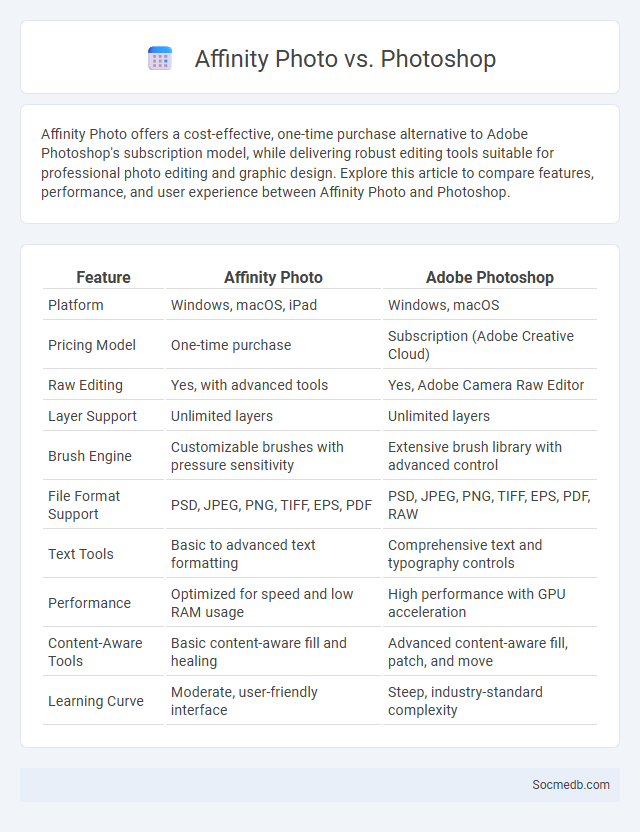
Photo illustration: Affinity Photo vs Photoshop
Affinity Photo offers a cost-effective, one-time purchase alternative to Adobe Photoshop's subscription model, while delivering robust editing tools suitable for professional photo editing and graphic design. Explore this article to compare features, performance, and user experience between Affinity Photo and Photoshop.
Table of Comparison
| Feature | Affinity Photo | Adobe Photoshop |
|---|---|---|
| Platform | Windows, macOS, iPad | Windows, macOS |
| Pricing Model | One-time purchase | Subscription (Adobe Creative Cloud) |
| Raw Editing | Yes, with advanced tools | Yes, Adobe Camera Raw Editor |
| Layer Support | Unlimited layers | Unlimited layers |
| Brush Engine | Customizable brushes with pressure sensitivity | Extensive brush library with advanced control |
| File Format Support | PSD, JPEG, PNG, TIFF, EPS, PDF | PSD, JPEG, PNG, TIFF, EPS, PDF, RAW |
| Text Tools | Basic to advanced text formatting | Comprehensive text and typography controls |
| Performance | Optimized for speed and low RAM usage | High performance with GPU acceleration |
| Content-Aware Tools | Basic content-aware fill and healing | Advanced content-aware fill, patch, and move |
| Learning Curve | Moderate, user-friendly interface | Steep, industry-standard complexity |
Introduction to Affinity Photo, Photoshop, and Thumbnail Design
Affinity Photo and Photoshop are leading software tools for creating high-quality social media graphics that capture audience attention. Thumbnail design plays a crucial role in boosting your content's visibility by using vibrant colors, clear text, and compelling images to entice clicks. Mastering these tools enhances your ability to produce visually engaging social media posts that drive engagement and grow your online presence.
Key Features Comparison: Affinity Photo vs Photoshop vs Thumbnail Tools
Affinity Photo excels in intuitive layer management and non-destructive editing, offering advanced RAW processing and comprehensive retouching tools tailored for social media content creators. Photoshop provides industry-leading features like Adobe Sensei AI-powered enhancements, extensive brush libraries, and seamless integration with Adobe Creative Cloud, ideal for professional-grade social media graphics and complex compositions. Thumbnail tools such as Canva specialize in user-friendly drag-and-drop interfaces, predefined social media templates, and quick export options, streamlining the creation of eye-catching thumbnails optimized for platforms like YouTube and Instagram.
User Interface and Ease of Use
A well-designed user interface enhances social media platforms by offering intuitive navigation and clear layout, allowing users to find features effortlessly. Ease of use is crucial for engaging diverse audiences, enabling you to interact, share, and connect without technical barriers. Optimized interfaces increase user retention by providing seamless experiences across devices and screen sizes.
Performance and System Requirements
Social media platforms require high-performance servers and optimized content delivery networks (CDNs) to handle millions of simultaneous users and real-time data exchanges. Your device should meet system requirements such as a minimum of 4GB RAM, a stable high-speed internet connection, and updated browsers or apps to ensure smooth interaction and fast loading times. Efficient backend algorithms and scalable cloud infrastructure are essential for maintaining optimal responsiveness and user experience.
Image Editing Capabilities
Social media platforms increasingly offer advanced image editing capabilities, enabling you to enhance photos with filters, adjustments, and augmented reality effects directly within the app. These tools include cropping, color corrections, retouching, and creative overlays that help create visually compelling content tailored for specific audiences. Leveraging these features boosts engagement by making your visuals stand out in crowded feeds and stories.
Pricing and Subscription Models
Social media platforms employ diverse pricing and subscription models, ranging from free access supported by advertising revenue to premium subscriptions offering ad-free experiences and exclusive features. Platforms like LinkedIn and YouTube generate significant income through tiered subscriptions, such as LinkedIn Premium and YouTube Premium, which provide enhanced functionalities including advanced analytics and offline access. Emerging trends include micro-subscriptions and bundled services, optimizing user engagement and monetization strategies.
Compatibility and File Format Support
Social media platforms offer broad compatibility with various devices and operating systems, ensuring seamless access and interaction for Your audience. They support multiple file formats, including JPEG, PNG, MP4, and GIF, enabling diverse content such as images, videos, and animations to be easily uploaded and displayed. This compatibility and file format support enhance user engagement and content versatility across platforms like Instagram, Facebook, Twitter, and TikTok.
Community, Tutorials, and Support
Social media platforms cultivate vibrant Communities where You can connect with like-minded individuals and share experiences. Comprehensive Tutorials empower users to master new skills through step-by-step guides and video content. Dedicated Support teams ensure swift resolution of issues, enhancing Your overall social media experience.
Best Use Cases: Affinity Photo, Photoshop, or Thumbnail Editors?
Social media content creation thrives with tools like Affinity Photo, Photoshop, and thumbnail editors, each serving unique use cases to boost visual appeal and engagement. Affinity Photo offers powerful photo editing with a one-time purchase model, ideal for budget-conscious creators who need professional results, while Photoshop excels with extensive features and integrations perfect for complex projects and branding consistency. Your choice depends on workflow needs; thumbnail editors provide quick, eye-catching graphics essential for increasing click-through rates and audience retention on platforms like YouTube and Instagram.
Conclusion: Which Tool Should You Choose?
Choosing the right social media tool depends on your specific goals, audience, and content strategy. Platforms like Instagram excel in visual storytelling, while LinkedIn is ideal for B2B networking and professional content. Prioritize tools that align with your brand's objectives, offer robust analytics, and enable efficient audience engagement to maximize your social media impact.
 socmedb.com
socmedb.com